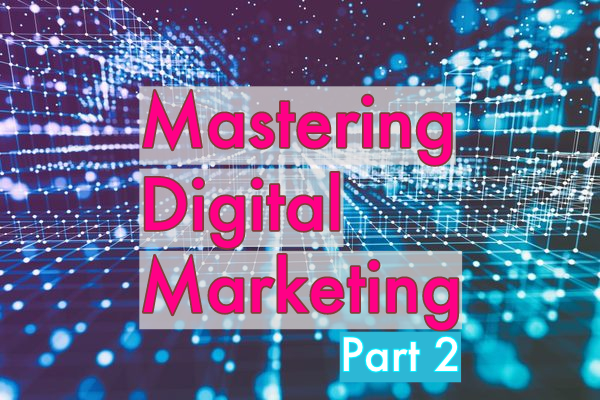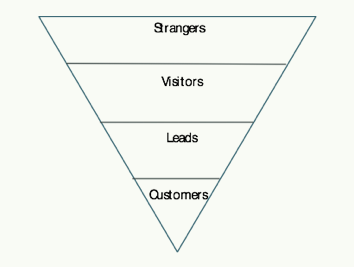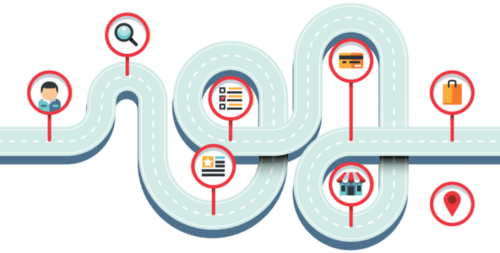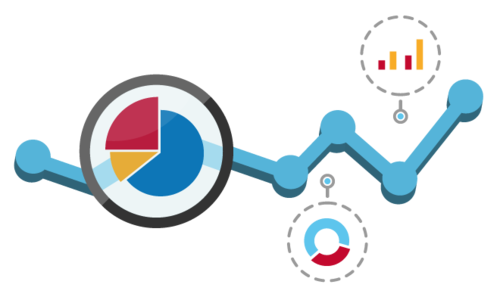
The marketing funnel
The marketing funnel is the set of phases a potential customer passes through in the process of going from being a stranger to your company to becoming persuaded and making a purchase decision. It is the marketer’s view of how potential customers pass through the buying process.

The marketing funnel contains these steps:
– Initially strangers are attracted to come to your website using means like search engines (such as Google), social media, paid advertisements, or offline marketing.
– When strangers arrive at your website, they become anonymous visitors.
– If visitors register their contact information in a form on the website, they become leads.
– Once a lead has been persuaded to give you the purchase order, you close the deal and they become a customer.
The top of the marketing funnel is wide because many strangers come to your website, thus becoming visitors. The middle of the funnel is narrower since not all visitors will register their contact information and become a lead. The bottom is smaller still, since many leads don’t buy anything.
Sometimes a fifth step is added to the marketing funnel when delighted customers become promoters and start to spread the word about your fantastic product to new strangers, and the process starts all over again.
Each potential customer is in one of the stages in the marketing funnel at a given time, and the strategies to move him or her forward towards the purchase decision is different along the way. The types of marketing information to offer the customer are also different at various stages in the funnel.
To get more sales, you need to optimize your efforts for each phase of the marketing funnel to:
– Attract more strangers
– Convert more anonymous visitors into identified leads
– Convince more leads to buying your product
This post will teach you up-to-date techniques for improving all these areas.

The customer journey
The marketing funnel is your view of how a potential customer passes through the buying process, and the customer’s journey is the same process seen from the other side.
Customer’s go through an information gathering process with specific touch points on their way to making the purchase decision.
With more information about what actions leads typically take before making a purchase decision, and where a particular visitor is in that process, you can offer targeted marketing information at the right time.
– In the awareness stage, potential customers realize they have a problem they might want or need to have solved. This is early in the customer journey and your marketing information should be focused on problem solving or improvement topics.
– In the consideration stage, potential customers make an effort to learn more to find a solution to their problem. This is in the middle of the customer journey when they are searching for more solution-oriented and detailed knowledge of your product’s capabilities.
– The end is the decision stage, where the potential customer wants to know how your product compares or performs compared to another vendor’s products. Here you can focus on product information or comparisons, and relationship building using for example webinars, consultations, or product demos.
For each of these stages, the potential customer may have several or many touch points with you, and you should offer marketing content to support that. In fact, you can even chart the customer journey and plan the unique content you want to provide to potential customers at each stage of the customer journey. This is called the customer journey map.
Buyer personas
Before you start any active marketing, you should also consider who you want to market and sell to. With a clear picture of your target market, you will be more successful and see better results. Buyer personas define who you want to reach, what type of marketing information will be most successful with them, and the type of websites they frequent.
What is a buyer persona? This is an ideal fictional customer that helps you understand who you market to. A buyer persona is not a real person, it is a generalization of clients with similar behaviors, needs, or wishes, and perhaps demographic information.
You probably have several different buyer personas in your business. For example, a company selling boats and boating equipment may identify these as the most significant buyer personas:
– Joe the young professional looks for a speedboat. He is interested in fast and cool boats and plans to use it to bring friends out for fun weekends. He is likely to be 20-30 years old and have a decent salary and few worries in life.
– Mark the father wants to bring his wife and small children out for short trips during good conditions and worries more about safety and comfort than speed and style. He is probably between 35-50 years of age and needs to use most of his income on other things.
– Caroline the teenager loves windsurfing, and is entirely focused on the sports experience. While she does not have a good income yet, she prefers windsurfing gear from well-known vendors with a high coolness factor.
With a clear picture of what buyer personas you want to reach, you can adapt your website and other online marketing content to fit them perfectly. In short, you should care less about having any stranger coming to your website, and focus instead on attracting the right visitors to your website who best match your product—and are most likely to buy it.
By identifying personas, you define the categories of the people you want to reach. All your marketing content thereafter should be optimized to fit your buyer personas. Clearly defined buyer personas also help you discover where your prospective customers spend time on the Internet, which tells you where to promote your business. Start to promote to your most important buyer persona first, and over time you can add campaigns and content better optimized for the other ones.
Well-defined buyer personas can give better value for money in promotion investments if your marketing content is consistently optimized for them.

Segmentation
Segmentation is about filtering your leads database in different ways, with the purpose of providing focused marketing information to your leads. With a segmented address list, you can send a campaign mailshot to only those leads that are most likely to be interested in that offer. A discount offer on women’s clothing may not be as effective if you send it to men, for example.
Segmentation provides you with the means to send certain marketing messages to special groups of leads in your database. Segmentation can be done based on who the leads are (their demographics) or what they have done (their past behavior).
– With demographic filtering, you segment leads based on where they live, their sex, age, or income. Other types of information may be placed in this category as well, such as job title, company size, industry, and interests.
– With behavior filtering, you segment leads based on what they have done previously, for example what emails they have opened and clicked, what social media interactions they have had with your company, what web pages or blog articles have they read, or how often they return to your website.
Always try to provide a relevant marketing message by segmenting your leads, and only send marketing information to groups of leads that have an interest in that topic.
Attracting visitors
To reduce your marketing spending, you will need to find free or inexpensive ways to attract visitors to your website. The trick here is digital content and search engines.
Google and other search engines index websites and recommend them when someone searches for a particular set of keywords that match the contents of a web page. By ensuring your pages turn up early in the search engine result pages (SERP), it is likely the person searching for the keywords will click the links to visit your site.
The more web pages you have with information related to a specific set of search keywords, the greater the chance one or more of those pages ends up early in the search results and gets clicked. In short, by writing several web pages touching on relevant subjects, more visitors can be sent to you from search engines such as Google, Bing, or Yahoo.
How do you write a lot of web pages with information related to the same search keywords? One strategy is to have a large website with lots of pages containing similar information targeting the same keywords. This only works to a certain extent, as the website eventually starts to look weird if you have too many pages with similar or unnatural content.
The better approach, now being used by many online marketers, is to complement the website with a blog. Since a blog is essentially a flow of informal articles on almost any topic, it is much easier to create one with many articles. They can all touch upon similar — or for that matter, different — subjects. It looks natural to have many blog articles covering similar topics, as long as you modify them somewhat and mix them with other topics in between.
With inbound marketing, having a lot of content is everything. Create a large website with many web pages, but most importantly, create an active blog that over time will contain hundreds of articles discussing things at least partially related to your product or industry.
The process is similar to fishing with a net: if you throw out a small net into the lake, you will only get a couple of fish. But with a net ten times larger, you will get ten times more fish. The same is true for online content. The more web pages and blog articles you have on a subject, the bigger the chance search engines will send traffic (visitors) to you whenever someone searches for relevant keywords.
Receiving visitors from search engines (this is called organic traffic) is one thing, but you also want to delight and impress them to keep them around for as long as possible. This allows you to engage with them more, expose them to your thought leadership, and present trust building content.
Your digital content should always be of high quality, with information that is genuinely useful or valuable to your visitors. If visitors only get a sales pitch, they are unlikely to hang around your site. To keep their attention, offer information, training material, or thoughts that are of genuine interest, have educational value, or otherwise solve a problem or pain point for them.

Converting visitors to leads
Provided you have a website and blog to attract visitors with the help of search engines, how do you turn these anonymous visitors into leads you know something about (in particular, their contact information)? The primary means of converting anonymous visitors into identified leads is to make them fill out their contact information in a registration form.
To give their contact information to you, they must trust you and be delighted with the valuable information or knowledge they have gained by visiting your website or blog. But this is often not enough, since many people won’t submit their information just because they like your site or have been asked to.
You will have to provide something of real value in return for their contact details. In short, the trick is to offer a digital asset they desire. This can be something like a white paper, a video tutorial, an eBook, a checklist, an Excel calculation formula, a Word document template, or a training webinar. To get access to the digital asset, visitors have to register their contact information in a web form.
In effect, visitors buy the digital asset and pay with their contact information. Once you have the details of a lead, you can start to engage with him or her, and set up various nurturing strategies to move the lead further down the customer journey and closer to the sale.
Leads nurturing
Your marketing efforts attracted new visitors to your website and converted them into leads using registration forms. Now your goal is likely to make a new lead buy something from you, but he or she may not be ready for a purchase decision just yet.
Your job is to nurture the lead until the time is right, making sure your company or product continues to be in the top of his or her mind. At the same time, you should try to make the leads engage more deeply with you over time. This leads nurturing is usually done by sending automatic emails.
Not too many years ago, online leads nurturing was almost only about sending the same batch email to everyone in a database, often in the form of a monthly newsletter email. While sending newsletter emails are becoming less effective, email marketing is not dead and is not likely to go away for a long time. But to be effective, your emails need to be more personalized and relevant to your recipients.
Today, online leads nurturing includes sending a series of emails with a consistent purpose when the lead engages with you in some way. Using a well-designed leads nurturing concept increases the likelihood you are remembered when the time is right, and that your product or service is shown in the best light.

Measuring success
To measure if you are successful with your online presence, you need to know how well you perform on the most important metrics. It is essential to record and analyze the origin and behavior of website visitors, the conversion ratio of various marketing campaigns, and the effectiveness of other related online and offline marketing efforts.
This is done using web analytics tools, which help you understand where your visitors come from, what web pages attract or scare them away, how they move around your site, how different segments of visitors behave in relation to others, and to what extent goals are fulfilled.
By measuring and analyzing your current situation, and how changes affect the results, you can improve the user experience and increase your goal conversion ratio. Measuring, analyzing, modifying, and testing the results is a continuous process that should be performed frequently. It is not a one-time activity.
Measuring success using web analytics tools ties back to the goals and KPIs you should have defined for your online presence.
Summary
In this chapter, we discussed the importance of setting goals, and how interruptive and annoying outbound mass marketing strategies are increasingly being replaced with inbound content techniques. This provides educational and useful information that the potential customer actively looks for and finds valuable, thus helping them to come to you and chose your product.
The marketing funnel and the customer journey was described, as were buyer personas and leads segmentation. These are key to understanding what marketing content is suitable for whom, and when. We also looked at a quick overview of attracting visitors using a website and blog, along with information on how to convert anonymous visitors into identified leads.
Leads nurturing using different email marketing strategies were covered, as well as an introduction to website usage analysis with web metrics and Google Analytics. The next part (part 3) provides information on how to attract visitors.
End of “Mastering Digital Marketing, Part 2”.